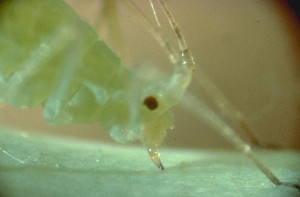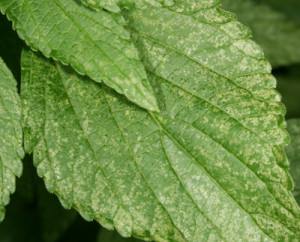Introduction • FAQs • Sap-feeding insects • Mesophyll-feeding insects
Introduction

A tiny aphid presses its sucking mouthparts against a plant leaf to feed. Inside the visible mouth is an even tinier, set of hypodermic needle-like mouth parts that draw sap from plant veins.
Insects that use special sucking mouth parts to feed on sap and plant cells include some of the most diverse and interesting insects in the garden. They can also be some of the most destructive pests in home landscapes. Unlike the beetles and ants with their chewing mouth parts, insects that feed on sap have piercing/sucking mouth parts. Damage from sap feeders can be difficult to spot at first. After a while, however, plants being attacked by sap-feeders will take on a shiny look and sticky feel. Eventually these sticky plants may turn black with a coating of black sooty mold, a type of fungus that grows on the sugars in the drippy droppings of sap-feeders. Common sap-feeding insects include mealybugs, scale insects, aphids, true bugs and whiteflies.

Leafhopper feeding damage to mint. The lighter-colored spots are typical of damage caused by mesophyll-feeding insects and mites.
Not all plant-feeding insects with sucking mouth parts feed on sap. Some feed on the inner tissues of leaves, called mesophyll (MEEZ oh fill). Mesophyll includes the food producing (photosynthetic) cells layers of a leaf that lie between the upper and lower epidermis. Symptoms of mesophyll feeding include a stippled pattern of yellowish, gray or whitish dots on the plant surface. This damage causes the leaf color to dullen, turn yellow or gray, and eventually brown. Other mesophyll feeders may leave pits or sunken areas of leaves that eventually turn brown and die. Spider mites, leafhoppers, lace bugs and yucca bugs are examples of mesophyll-feeders common in Texas landscapes.
Frequently Asked Questions
- What is sap?
- What are mouthparts on insects like, and how can I see them?
- What is a systemic insecticide?
Sap-feeding insects
- Aphids in Texas Landscapes (E-311) Aphids are among the most common sucking insect pests on Texas landscape plants. Found on leaves, stems, and even roots of plants, aphids feed on the phloem (sap) and leave behind weakened plants and sticky honeydew.
- Box elder bugs (E-453) Box elder bugs feed with their piercing sucking mouthparts fmaple and box elder seeds. While this does no damage to the tree, their presence in and around the home is a concern.
- Chili thrips (EEE-000412) Though not a true sap-feeding pest, these tiny insects are becoming an increasingly important and serious pest in roses.
- Crape Myrtle Bark Scale: A New Exotic Pest. (EHT-049) Official Extension publication on this new pest of crape myrtle.
- How to treat your crapemyrtle for bark scale – Video This page connects with a 9-minute video that will walk you through all the steps of using a liquid systemic insecticide for controlling CMBS.
- Crape Myrtle Bark Scale Tracking The EDDMapS website allows you to report and verify new locations of this scale. If you believe you have CMBS on your crape myrtle, check out this site. You can upload your own pictures for expert verification and literally put your pest on the map. If you are outside the Dallas Fort Worth area, especially, your reports are needed.
- Crape Myrtle bark scale (Insect Update April 3, 2014) Latest update on the identity of a new scale pest on this popular tree.
- Crape Myrtle bark scale (Insect Update May 10, 2010) A new scale pest on crape myrtle turns bark black and is tough to control. Learn more about control.
- Four-lined plant bug is a black and yellow striped bug that attacks many garden flowers. From Insect Updates, May 2010.
- Pink hibiscus mealybug – New Texas pest (E-454) This new mealybug pest attacks over 300 species of plants and forms dense colonies with heavy wax buildup.
- Scale insects (B-6097) One of the more important, sap-feeding pest groups. Some scales are very difficult to find and control. This publication provides an overview of scale insects and control recommendations.
- Cycad aulacaspis scale (EEE-00038) Another recent scale pest, this is a major pest of sago palms.
- Wax scales on holly (L-5479) Large white scales on holly and many other plants.
- Whiteflies (E-432) Very small insects that feed on the undersides of leaves and produce honeydew, the name comes from the tiny, white adults that hover around infested plants.
Mesophyll-feeding insects and mites
- Spider mite control by CSU Colorado State University provides a good summary of spider mites and control options.
- Lace bugs by University of California. Lace bugs are common pests of ornamental trees and shrubs in Texas. This publication tells how to identify these insects and offers control options.